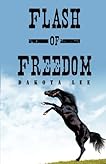 Flash of Freedom
Flash of Freedom by
Dakota LeeMy rating:
3 of 5 starsAn impressive first novel by twelve-year-old Dakota Lee,
Flash of Freedom is the story of a lonely, introverted teenager whose life is changed forever when she meets Freedom, a damaged, spirited horse.
Tara Chandler has been on the move most of her young life, her parents are house designers and always relocating the family for their work. Moving so often means that Tara rarely has the opportunity to make friends or, if she does, she has to say goodbye to them all too soon. So Tara has decided that in Green River, Tennessee - her latest new home - she doesn’t need friends, she won't try to belong to one of the groups at school; she will be fine just by herself. Until, that is, Tara meets Nicky.
Nicky, a friendly, horse-loving girl who never stops talking, breaks the mold of the "unfriendly local"; she is interested in Tara and welcoming on Tara's first day at school, introducing her to friends Amber, Casey and Lea, and including Tara in their get-togethers. Tara is confused and initially wary of this interest. Why are Nicky and her friends being so friendly? Is this a trick? It must be a fluke, they can’t really enjoy Tara’s company. But their shared love of horses and Nicky’s sunny, open nature disarms Tara and she starts to relax, enjoying the time she spends with her new friends.
Tara is particularly happy to be involved with Nicky’s latest project - helping Nicky's Aunt Fauna settle three horses into the barn on her parents’ property by clearing the barn and paddock of debris and getting everything clean and tidy. The horses arrive and Tara meets Freedom, the spirited eponymous ‘hero’ of the book. Like Tara, Freedom has moved around a lot and like Tara he is slow to trust people. He has been classed untrainable by Aunt Fauna but she unwillingly allows Tara the opportunity to attempt the training of Freedom herself. With patience and love, Tara teaches Freedom to trust again. And with the confidence this mutual trust brings, Tara finally starts to come out of her shell and show a new happiness to her friends and family.
But then the unthinkable happens. Freedom is stolen. And Tara almost loses faith ... until she finds Freedom again in the most unlikely place, and uses the support of her friends and her newfound inner strength and confidence to face down the thief, take back her horse and regain her happiness.
Dakota Lee’s writing in
Flash of Freedom is fresh and engaging, the main character sympathetic not saccharine. Tara isn’t a goody-goody, or a cardboard cut-out; she bickers with her brother, is sometimes flippant to her parents and gets caught not concentrating in class. The opening chapter describing Tara's analysis of the boys and girls on the bus with her, allocating them their place in the school "monarchy"- the school nerd, the jock, the "populars" and the "groupies" - is well-written and amusing and introduces the main theme of the book. The dialogue is realistic; the slang and local dialect are introduced subtly without caricature. For example, Nicky “...[has:] so got it in the bag.” Lee's adult characters in the book are perhaps not as convincingly drawn, and their dialogue does not quite ring true at times, but that is a minor quibble.
A moving portrait of a young girl trying to find her place in life,
Flash of Freedom is recommended reading for any young adult, not just for girls who love horses.
View all my reviews >>

 Flash of Freedom by Dakota Lee
Flash of Freedom by Dakota Lee
 Seven Steps on the Writer's Path: The Journey from Frustration to Fulfillment by Nancy Pickard
Seven Steps on the Writer's Path: The Journey from Frustration to Fulfillment by Nancy Pickard

